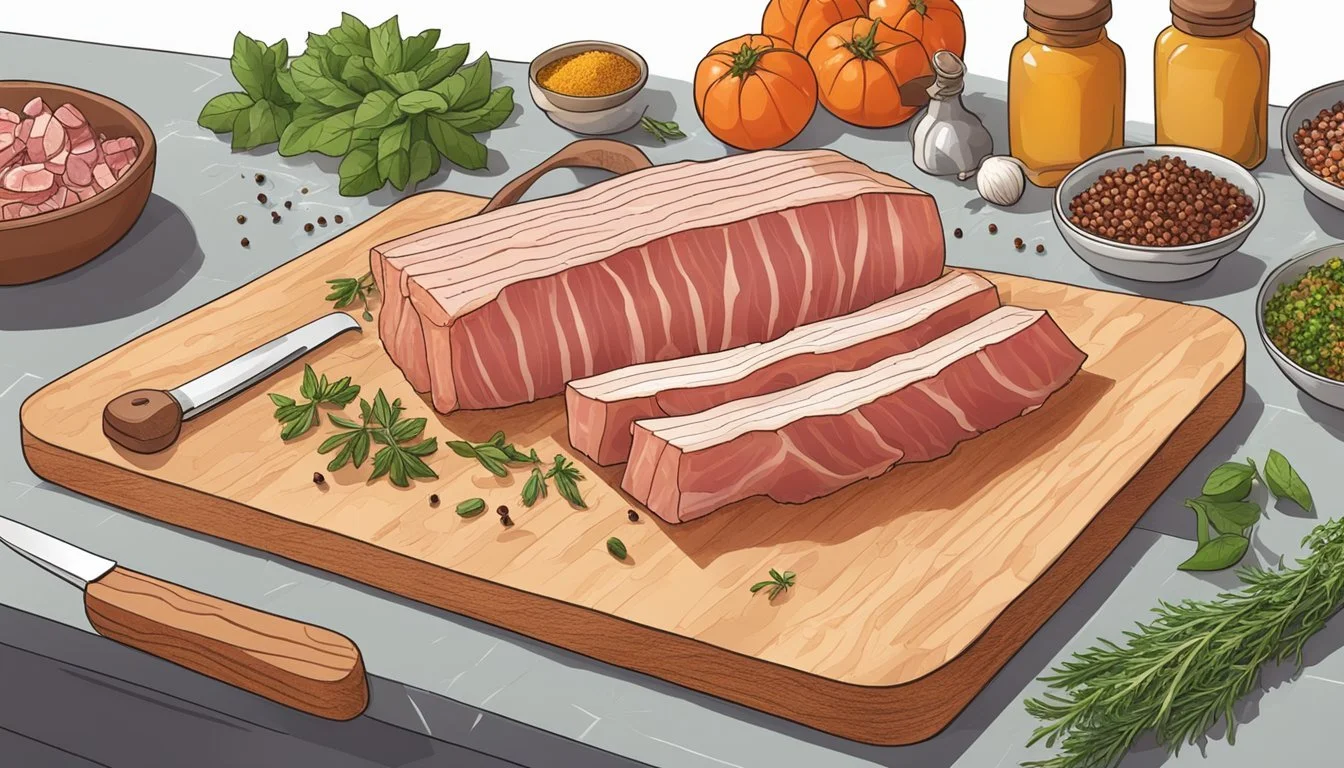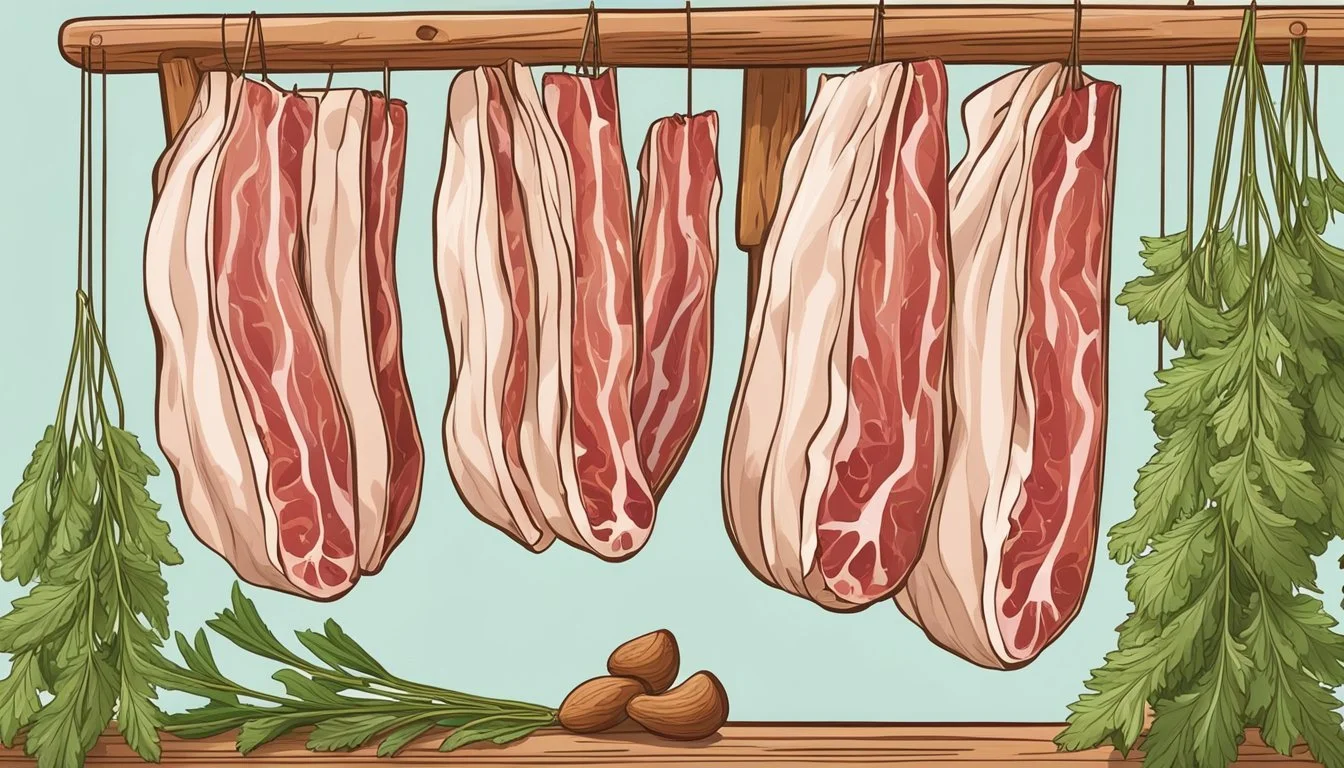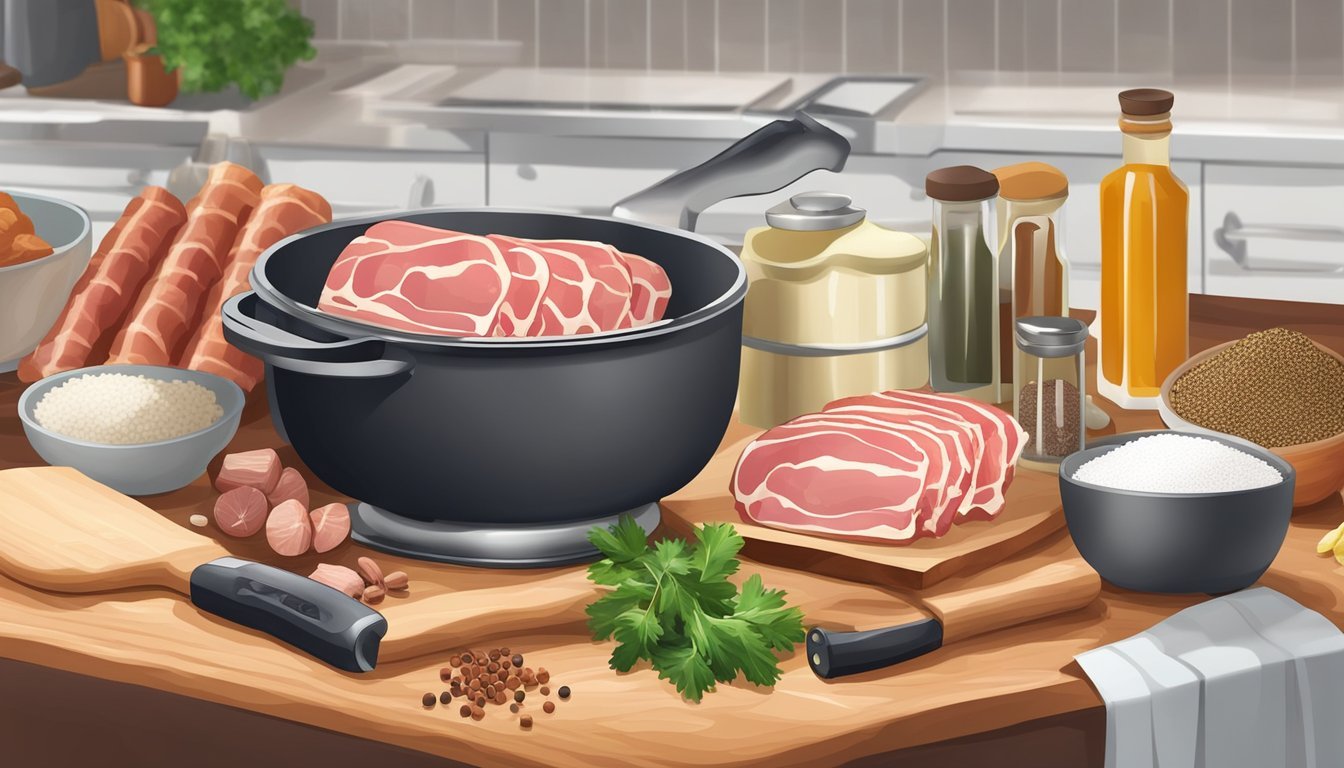Homemade Pancetta
Your Comprehensive DIY Guide to Curing Italian Bacon
Making pancetta at home is a rewarding process that allows cooks to explore the traditional Italian methods of curing meat. Pancetta, often referred to as Italian bacon, is pork belly that has been seasoned with a blend of salt, pepper, and various spices before being left to cure. Unlike bacon, which is typically smoked after curing, pancetta is usually rolled and air-dried, yielding a savory component with a distinct, robust flavor. As with any time-honored culinary practice, patience and attention to detail are the cornerstones of creating a successful homemade pancetta.
The preparation begins with a careful selection of quality pork, followed by a thorough mixing of the curing ingredients. The mixture often includes kosher salt, fresh ground black pepper, and an assortment of herbs and spices, such as juniper berries, rosemary, and thyme, which imparts a unique aroma to the meat. After curing, the pork belly may be tightly rolled into a log and then wrapped, typically in cheesecloth, to protect it during the drying phase. The meat must be stored in a controlled environment, where temperature and humidity levels are monitored to foster safe, proper curing.
The drying process is not to be rushed; it can span from a few weeks to several months. Throughout this time, the pancetta develops its signature texture and concentrated flavors. Once dried, it can be sliced thinly and used to enhance a variety of dishes, from simple pasta to more complex culinary creations. Home chefs who undertake this process not only enrich their cooking repertoire but also forge a deeper connection with the artisanship behind Italian charcuterie (What wine goes well with charcuterie?).
Understanding Pancetta
Pancetta is a traditional Italian cured meat known for its savory taste and versatility in cooking. This section explores its distinction from bacon, historical roots, and significance in Italian cuisine.
Pancetta Vs. Bacon
Pancetta and bacon are both made from pork belly, but their preparation methods and culinary uses differ significantly. Pancetta is seasoned with a variety of spices such as black pepper, juniper berries, and other herbs, then dry-cured and sometimes rolled into a log. It is consumed either thinly sliced and uncooked or cooked to add depth to dishes. On the other hand, bacon is typically cured with salt and smoked, resulting in a different flavor profile and texture. This table compares the two:
Feature Pancetta Bacon Curing Method Dry-cured with spices Cured with salt and smoked Typical Use Eaten raw or cooked Usually cooked before eating Flavor Delicate, with a peppery, herbal taste Smoky, salty flavor Origin Italian Various, with a popular style from America
History and Origin
Pancetta is steeped in Italian tradition, with its origins dating back to the Middle Ages. It was developed as a means to preserve meat for long periods. The curing process was essential in the days before refrigeration, utilizing salt and natural climatic conditions to prevent spoilage. Even to this day, the production of pancetta involves a period of air-drying that can last from several days to months, depending on the desired result.
Pancetta in Italian Cuisine
Italian cuisine makes prolific use of pancetta, where it is cherished for its ability to impart rich flavors to a variety of dishes. From pasta sauces to stews and even as a wrapping for other proteins, pancetta is versatile. It's particularly common in recipes such as spaghetti carbonara and as part of the flavor base known as soffritto, where it's sautéed with ingredients like onions, carrots, and celery to create a foundational flavor for soups and sauces. Pancetta adds a distinctive Italian signature to culinary creations, enhancing flavors without overwhelming them.
Essential Ingredients
Creating your own homemade pancetta involves carefully choosing quality ingredients that will impact the flavor and safety of your finished product. Proper selection and handling of these ingredients are paramount for a successful outcome.
Selecting Pork Belly
When making pancetta, the selection of pork belly is crucial. Pork belly should be fresh, with a firm texture and a good proportion of meat to fat. This cut is the very essence of pancetta, providing the rich flavor and luscious texture pancetta is known for.
Salt and Spicing
For seasoning the pork belly, the use of kosher salt is often preferred due to its pure and consistent granule size, which aids in the curing process. A balanced blend of black pepper, juniper berries, bay leaves, nutmeg, thyme, sage, and garlic provides the classic aromatic profile of pancetta. Spices should be crushed or ground to ensure even distribution and optimal infusion of flavor.
Kosher Salt: Essential for curing, draws out moisture.
Black Pepper: Provides a sharp, piquant taste.
Juniper Berries: Add a piney, slightly citrus flavor.
Bay Leaves: Lend a subtle, herbal quality.
Nutmeg: Contributes a warm, nutty essence.
Thyme & Sage: Offer earthy and peppery notes.
Garlic: Infuses a pungent, characteristic aroma.
Role of Curing Salts
Curing salts, specifically pink curing salt (containing nitrite and/or nitrate), are non-negotiable in the making of pancetta. They are utilized to prevent the growth of bacteria, contribute to the preservation of the meat, and help maintain a pink coloration. Curing salt must be measured precisely: too little fails to inhibit bacteria effectively while too much can be toxic.
Pink Curing Salt: A precise mix of standard salt and nitrite/nitrates, key in preventing botulism and ensuring proper cure.
Brown Sugar or Sugar: Optional for balance, they temper the saltiness and assist with the curing process.
Preparing the Cure
The quality of homemade pancetta hinges on the cure, which is a blend of salt and spices that seasons the pork belly and assists in preservation. Getting the mixture right is essential for developing the right flavor and texture in the final product.
Mixing the Spices
To create the cure, one begins by selecting the appropriate herbs and spices. The staple ingredients typically include:
Kosher salt: the base of the cure, drawing out moisture and aiding in preservation
Black pepper: for a classic peppery note
Ground juniper berries: for a slightly fruity undertone
Prague powder #2: a curing salt containing sodium nitrate, used for long curing processes
Minced garlic: adds depth and aroma
Brown sugar: balances the salt with a hint of sweetness
Fresh rosemary: for a woodsy flavor
Thyme: adds a subtle layer of earthy notes
Combine all the spices and seasonings in the following proportions to ensure consistent flavor throughout:
Ingredient Quantity Kosher salt 1 cup Black pepper 1/4 cup Ground juniper berries 2 tbsp Prague powder #2 2 tsp Minced garlic 4 cloves Brown sugar 1/2 cup Fresh rosemary 3 sprigs Thyme 2 tsp
Mix these ingredients well until the blend is homogeneous.
Applying the Cure
Once mixed, apply the cure to every surface of the pork belly evenly, ensuring to reach every nook. For effectiveness, here is the straightforward process:
Lay the pork belly flat: Ensure it is rinsed and patted dry.
Distribute the cure: Rub the mix thoroughly onto the pork belly.
Refrigerate the meat: Place the coated pork belly into a nonreactive container, cover it, and refrigerate according to the following schedules:
For a basic cure: Refrigerate for 24 hours.
For thicker cuts: Refrigerate for up to 7 days, flipping the meat daily to ensure an even cure.
During this phase, the cure draws out moisture and imbues the pork with the flavors of the spices and herbs while the salt works to inhibit bacterial growth. After the curing time, rinse the excess salt and seasonings off the pork belly, and pat it dry before proceeding to the next steps of the pancetta-making process.
Curing and Storage
Curing pancetta is a methodical process that involves precise temperature and humidity control, as well as specific timeframes to ensure proper flavor and texture development. Proper wrapping and refrigeration in the initial stages give way to careful monitoring during the drying period.
Wrapping and Refrigeration
Initially, one must wrap the seasoned pork in either cheesecloth or a vacuum seal to protect it while it rests in the refrigerator. The cheesecloth allows the meat to breathe, while a vacuum-seal bag can suffice if one seeks a more controlled environment. The pork should be placed on a tray or plate, and refrigerated for a period that typically spans five to seven days, depending on the size and thickness.
Monitoring Humidity and Temperature
Once wrapped, the pork belly must be stored in a cool environment with stable humidity and temperature. Ideal conditions for drying pancetta are a temperature range of 59°F to 77°F (15°C to 25°C) and humidity between 65% and 86%. One should use a hygrometer to measure these parameters, as fluctuations can drastically affect the end product.
Curing Time
The curing time for homemade pancetta can vary; however, clear guidelines exist. After the initial refrigeration, the meat needs adequate time to cure thoroughly. This typically entails a minimum duration of 7 days. During this time, one should check the pancetta regularly and adjust the environmental conditions if necessary to ensure the meat cures evenly and develops a firm texture.
Drying and Maturation
The crucial phase of drying and maturation develops the flavor and texture of pancetta. It requires careful monitoring of environmental conditions to ensure proper curing.
Hanging the Pancetta
After the initial curing process, the pancetta must be hung in a controlled environment. The space should maintain a consistent temperature of 50 to 60 degrees Fahrenheit (10 to 15 degrees Celsius) and a relative humidity of 60 to 75%. It is common to use twine for trussing and hanging the meat, which allows air to circulate evenly around the pancetta. A traditional place for hanging is in a basement, where conditions often naturally meet these requirements.
Preparation for Hanging:
Roll the meat tightly or leave it flat.
Truss with twine, ensuring even pressure is distributed along the meat.
Encase in natural casings or cheesecloth if desired to protect from contaminants.
Determining Readiness
Pancetta's readiness is judged by time and weight loss. The goal is typically a weight loss of 30% from the original weight, which can take several weeks.
Signs to Look For:
Absence of any off-odors.
Shrunken appearance indicating moisture loss.
Use of a paper towel to pat dry the exterior can be helpful for removing any excess moisture that may accumulate during the drying process. This step is crucial for maintaining the right conditions and preventing mold growth. Regular checks ensure that the pancetta matures correctly, leading to a beautifully cured end product.
Finishing Touches
Once the pancetta has been cured and dried to perfection, it's time to focus on the final steps to ensure its quality and longevity. This involves precise trimming and portioning for immediate use or future cooking, followed by proper storage techniques.
Trimming and Portioning
After the drying process, the pancetta should be inspected for any areas that may have dried differently. They can trim off any undesirable or overly hard sections. They should also remove the skin if the pancetta is skin-on. This skin can be set aside for other culinary uses, such as flavoring soups or stews.
The portioning of pancetta depends on the user’s need for different culinary applications. For small-scale use, one might cut it into lardons, thin slices, or small chunks. Chefs commonly prefer cutting larger slices for wraps or as a base for dishes. They should portion it with these intentions in mind:
Lardons: small cubes of pancetta, typically about 1/4 inch on each side.
Slices: thin sheets, resembling bacon, used for wrapping or layering.
Chunks: larger pieces for rendering or dicing, depending on the recipe.
Storing the Pancetta
Storing pancetta correctly is crucial to maintain its quality and extend its shelf life. For short-term storage, one can wrap the pancetta in parchment paper and then in plastic wrap or a resealable plastic bag, ensuring it’s stored in the coldest part of the refrigerator. For extended storage, vacuum sealing is an excellent option, as it removes air that could cause spoilage. Pancetta can be stored in the refrigerator for up to three weeks.
For long-term storage, freezing is an effective method. They should portion the pancetta as desired, wrap each portion tightly in cling film, and then place it in a vacuum-sealed bag before freezing. This will prevent freezer burn. When stored properly, it can last in the freezer for several months. Here's a simple table to summarize the storage methods:
Storage Method Condition Duration Refrigeration Wrapped in parchment and plastic Up to 3 weeks Freezing (Vacuum-sealed) Wrapped, vacuum-sealed, and frozen Several months
When ready to use frozen pancetta, they should thaw it in the refrigerator overnight to maintain the texture and flavor integrity.
Safety Considerations
When making homemade pancetta, ensuring safety is as critical as achieving delicious flavor. The key points of focus are preventing contamination during preparation and being aware of the risks associated with meat curing.
Preventing Contamination
One must be diligent about cleanliness when preparing pancetta to avoid bacterial growth. Using Ziploc bags or other airtight containers can be effective in reducing exposure to contaminants. Here are specific steps one can take:
Always start with a clean working surface and thoroughly wash hands before handling ingredients.
Use paper towels to pat dry the pork after rinsing, ensuring it is moisture-free, as moisture can encourage bacterial growth.
All utensils and containers used during the curing process should be sterilized to eliminate any existing bacteria.
Understanding Risks
The risks of preparing pancetta at home include potential bacterial contamination such as botulism, which can be fatal. Nitrites play a critical role in mitigating this risk. Here is what one should know:
Botulism is caused by a toxin produced by the Clostridium botulinum bacteria, which can thrive in the oxygen-free environment of improperly cured meats.
Nitrites, often found in curing salts such as Prague powder, combat this by inhibiting bacterial growth. Use them according to the recipe's precise measurements to ensure safety.
When used correctly, nitrites not only preserve the pancetta but also contribute to the development of its flavor and color. It's paramount that anyone curing meats at home understands these safety principles to ensure their homemade pancetta is both delicious and safe to consume.
Cooking with Pancetta
Pancetta, often referred to as Italian bacon, is a staple in Italian cooking and imparts a complex flavor to dishes. It is used to enhance pastas, soups, stews, and even vegetables like Brussels sprouts.
Incorporating into Recipes
When adding pancetta to recipes, it’s important to render it properly. Cook it over medium heat until the fat has been released and the pancetta is crispy. This technique not only cooks the pancetta but also leaves flavorful fat behind, which can be used to sauté other ingredients, imbuing them with richness.
Pasta Dishes: Pancetta is iconic in pasta dishes such as Spaghetti alla Carbonara. For a classic Carbonara, one would:
Dice the pancetta and render it until crispy.
Cook spaghetti and reserve some cooking water.
Whisk eggs and Pecorino Romano cheese, then combine with the spaghetti and pancetta, adding cooking water as needed to create a creamy sauce.
Vegetables: To elevate vegetables like Brussels sprouts:
Sauté diced pancetta until crispy.
Add halved Brussels sprouts to the pancetta fat, cooking until caramelized.
Mix with the pancetta and finish with a squeeze of lemon for brightness.
Substitutes for Pancetta
Although pancetta has a signature flavor, sometimes a substitute is necessary. Here are viable alternatives:
Bacon: Regular bacon can be used, but expect a smokier taste.
Smoked Ham: Chopped smoked ham can mimic pancetta’s meatiness.
Vegetarian Options: For a meat-free choice, try smoked cheeses or mushrooms for a similar umami depth.
When substituting, one should account for variations in saltiness and fat content. Reduce or omit additional salt as needed, and adjust cooking fat depending on the substitute's fat content.
Conclusion
This final section consolidates the journey of crafting homemade pancetta while also providing motivation for culinary enthusiasts to embrace the art of curing meat at home.
Recap of Homemade Pancetta
Homemade pancetta represents a pinnacle of charcuterie, showcasing the transformation of simple ingredients into a product with incredible depth of flavor. The process involves curing the pork belly with a meticulously balanced mixture of salt and a bouquet of aromatic seasonings. Cured pork belly, once properly prepared, can be rolled, tied, and left to dry, developing its characteristically savory and complex flavors. The steps outlined are not just instructions, but a passage to creating a culinary delight infused with love and tradition.
Encouraging Home Curation
The act of making pancetta at home is more than a recipe; it's a foray into the rich world of charcuterie. With the right conditions—cool, humid environments for drying—the process is entirely manageable. It brings a sense of accomplishment and can easily ignite a passion for further exploration into cured meats. Despite seeming daunting at first, the method is easy to learn and rewards the chef with a versatile ingredient that elevates any dish it accompanies. Fans of homemade delicacies are encouraged to embark on this rewarding journey, as it not only enhances their culinary repertoire but also ignites a deeper appreciation for the time-honored craft of meat curing.







